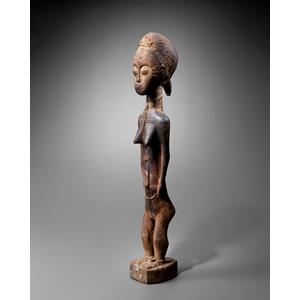DÉTAILS DE L'IMAGE

Montagut Gallery
Baule figure
Baule people, Ivory Coast, 19th century
Wood
H 60 cm
Provenance: André Blandin (1930-2015), France; Lucien Van de Velde, Antwerp, Belgium, end 1960s-1970; Marc Sherman, New York, acquired in 1982; Pace Gallery, New York; collection Patrick & Béatrice Caput, France, 1999; private collection, France
Literature: Boyer (Alain-Michel), Miroirs de l'invisible: la statuaire baoulé. Arts d'Afrique Noire, nº 45; Expo cat.: Objetos-Signos de Africa, Zaragoza, 2000: #27; François Neyt, Trésors de Côte d'Ivoire, Fonds Mercator, 2014 #174; Patrick Caput & Valentine Plisnier, Arts d'Afrique. Portraits d'une Collection, Milan: 5 Continents, 2016
Exhibition: Zaragoza, Spain: Objetos-Signos de Africa, Centro de Exposiciones y Congresos, 11 April-24 June 2000
André Blandin, the man who discovered this figure, was in charge of managing the food program for the populations affected by the development of the Bandama River valley, in the heart of Baule country. In constant contact with the villagers in his charge, he was able to develop his knowledge of Baule material culture, satisfy his taste for sculpture and hone his discernment, as evidenced by the choice of this moving female representation. The sight of her beautiful, enigmatic face, whose mischievous mouth belies the shyness of her modestly lowered eyes, raises questions about the use of this effigy.
Its exceptional size, the care taken by its creator in every detail and the presence of gold nuggets embedded in its forehead suggest that this sculpture fulfilled an extraordinary function, whatever its nature. With impeccably braided hair, straight torso, shoulders thrown back and knees slightly bent, it respects all the canons of one of the most classic and aesthetic styles of the Baule. The swan neck of the beautiful woman accentuates the impression of fragility and elegance that emanates from her slender figure and graceful body. The breasts, both firm and shapely, demonstrate the sculptor's virtuosity in combining youth and beauty.
The large size of this strikingly beautiful statuette and its crusty patina could represent an asie usu, a spirit of the terrestrial world. These genies of nature ask to be embodied in a beautiful statuette so that they can be consulted by a diviner. The rich, shiny and crisp patina that covers the head and body of this statue testifies to the care it has received.



 TÉLÉCHARGER L'IMAGE
TÉLÉCHARGER L'IMAGE